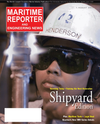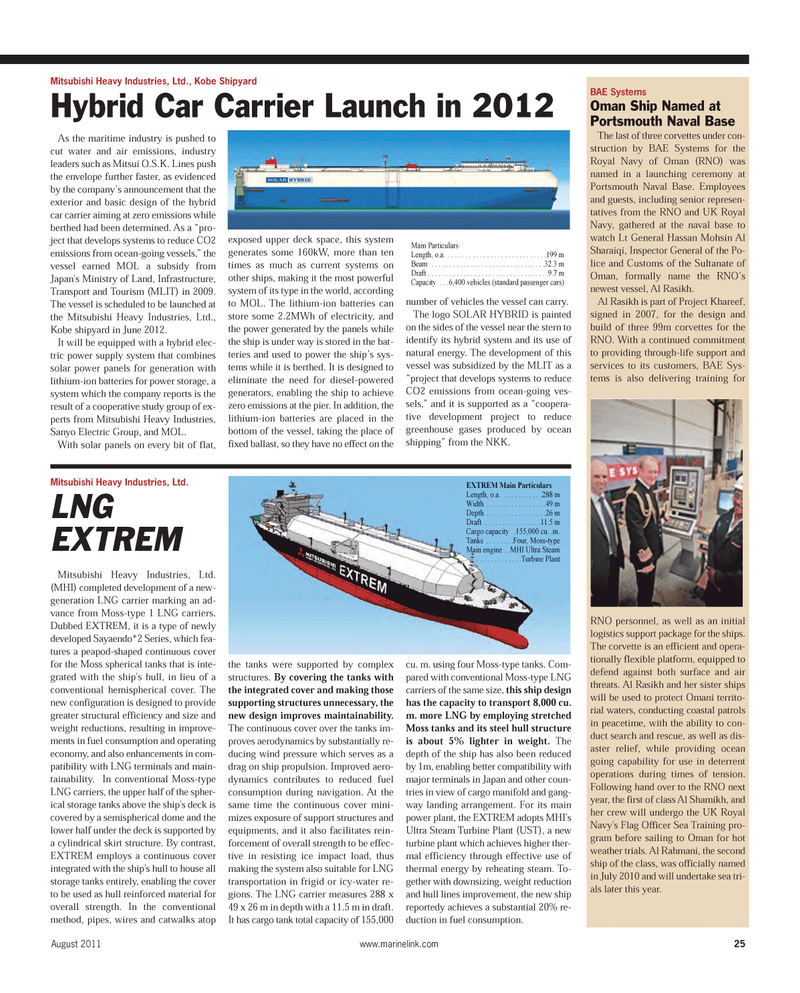
Page 25: of Maritime Reporter Magazine (August 2011)
Top 20 Shipyards of the World
Read this page in Pdf, Flash or Html5 edition of August 2011 Maritime Reporter Magazine
As the maritime industry is pushed tocut water and air emissions, industry leaders such as Mitsui O.S.K. Lines pushthe envelope further faster, as evidenced by the company?s announcement that the exterior and basic design of the hybrid car carrier aiming at zero emissions whileberthed had been determined. As a ?pro- ject that develops systems to reduce CO2 emissions from ocean-going vessels,? the vessel earned MOL a subsidy from Japan's Ministry of Land, Infrastructure,Transport and Tourism (MLIT) in 2009. The vessel is scheduled to be launched at the Mitsubishi Heavy Industries, Ltd., Kobe shipyard in June 2012. It will be equipped with a hybrid elec- tric power supply system that combines solar power panels for generation with lithium-ion batteries for power storage, a system which the company reports is the result of a cooperative study group of ex- perts from Mitsubishi Heavy Industries, Sanyo Electric Group, and MOL. With solar panels on every bit of flat, exposed upper deck space, this system generates some 160kW, more than ten times as much as current systems onother ships, making it the most powerful system of its type in the world, according to MOL. The lithium-ion batteries can store some 2.2MWh of electricity, and the power generated by the panels while the ship is under way is stored in the bat- teries and used to power the ship?s sys- tems while it is berthed. It is designed toeliminate the need for diesel-powered generators, enabling the ship to achieve zero emissions at the pier. In addition, the lithium-ion batteries are placed in thebottom of the vessel, taking the place of fixed ballast, so they have no effect on the number of vehicles the vessel can carry. The logo SOLAR HYBRID is paintedon the sides of the vessel near the stern to identify its hybrid system and its use of natural energy. The development of this vessel was subsidized by the MLIT as a ?project that develops systems to reduce CO2 emissions from ocean-going ves- sels,? and it is supported as a ?coopera- tive development project to reduce greenhouse gases produced by ocean shipping? from the NKK.August 2011www.marinelink.com 25Mitsubishi Heavy Industries, Ltd. (MHI) completed development of a new- generation LNG carrier marking an ad-vance from Moss-type 1 LNG carriers. Dubbed EXTREM, it is a type of newly developed Sayaendo*2 Series, which fea- tures a peapod-shaped continuous cover for the Moss spherical tanks that is inte-grated with the ship's hull, in lieu of aconventional hemispherical cover. The new configuration is designed to provide greater structural efficiency and size and weight reductions, resulting in improve- ments in fuel consumption and operatingeconomy, and also enhancements in com- patibility with LNG terminals and main-tainability. In conventional Moss-type LNG carriers, the upper half of the spher- ical storage tanks above the ship's deck is covered by a semispherical dome and the lower half under the deck is supported by a cylindrical skirt structure. By contrast, EXTREM employs a continuous cover integrated with the ship's hull to house all storage tanks entirely, enabling the cover to be used as hull reinforced material foroverall strength. In the conventional method, pipes, wires and catwalks atop the tanks were supported by complex structures.By covering the tanks with the integrated cover and making those supporting structures unnecessary, the new design improves maintainability. The continuous cover over the tanks im- proves aerodynamics by substantially re- ducing wind pressure which serves as a drag on ship propulsion. Improved aero- dynamics contributes to reduced fuel consumption during navigation. At the same time the continuous cover mini- mizes exposure of support structures and equipments, and it also facilitates rein- forcement of overall strength to be effec- tive in resisting ice impact load, thus making the system also suitable for LNGtransportation in frigid or icy-water re- gions. The LNG carrier measures 288 x 49 x 26 m in depth with a 11.5 m in draft.It has cargo tank total capacity of 155,000 cu. m. using four Moss-type tanks. Com-pared with conventional Moss-type LNG carriers of the same size, this ship designhas the capacity to transport 8,000 cu.m. more LNG by employing stretched Moss tanks and its steel hull structure is about 5% lighter in weight. Thedepth of the ship has also been reducedby 1m, enabling better compatibility withmajor terminals in Japan and other coun-tries in view of cargo manifold and gang- way landing arrangement. For its main power plant, the EXTREM adopts MHI's Ultra Steam Turbine Plant (UST), a new turbine plant which achieves higher ther- mal efficiency through effective use of thermal energy by reheating steam. To- gether with downsizing, weight reduction and hull lines improvement, the new ship reportedy achieves a substantial 20% re- duction in fuel consumption.Mitsubishi Heavy Industries, Ltd., Kobe Shipyard Hybrid Car Carrier Launch in 2012Main ParticularsLength, o.a. . . . . . . . . . . . . . . . . . . . . . . . . . . . .199 m Beam . . . . . . . . . . . . . . . . . . . . . . . . . . . . . . . .32.3 m Draft . . . . . . . . . . . . . . . . . . . . . . . . . . . . . . . . . .9.7 m Capacity . . .6,400 vehicles (standard passenger cars) Mitsubishi Heavy Industries, Ltd.LNG EXTREMEXTREM Main ParticularsLength, o.a. . . . . . . . . . . .288 m Width . . . . . . . . . . . . . . . . .49 m Depth . . . . . . . . . . . . . . . . .26 m Draft . . . . . . . . . . . . . . . .11.5 m Cargo capacity .155,000 cu. .m. Tanks . . . . . . . .Four, Moss-type Main engine . .MHI Ultra Steam . . . . . . . . . . . . . . .Turbine Plant BAE SystemsOman Ship Named atPortsmouth Naval BaseThe last of three corvettes under con- struction by BAE Systems for the Royal Navy of Oman (RNO) was named in a launching ceremony at Portsmouth Naval Base. Employees and guests, including senior represen-tatives from the RNO and UK Royal Navy, gathered at the naval base to watch Lt General Hassan Mohsin Al Sharaiqi, Inspector General of the Po-lice and Customs of the Sultanate ofOman, formally name the RNO?s newest vessel, Al Rasikh. Al Rasikh is part of Project Khareef,signed in 2007, for the design andbuild of three 99m corvettes for the RNO. With a continued commitment to providing through-life support and services to its customers, BAE Sys- tems is also delivering training for RNO personnel, as well as an initiallogistics support package for the ships.The corvette is an efficient and opera- tionally flexible platform, equipped to defend against both surface and air threats. Al Rasikh and her sister ships will be used to protect Omani territo- rial waters, conducting coastal patrols in peacetime, with the ability to con-duct search and rescue, as well as dis-aster relief, while providing ocean going capability for use in deterrentoperations during times of tension.Following hand over to the RNO next year, the first of class Al Shamikh, and her crew will undergo the UK Royal Navy's Flag Officer Sea Training pro- gram before sailing to Oman for hotweather trials. Al Rahmani, the second ship of the class, was officially named in July 2010 and will undertake sea tri- als later this year. MR Aug. 11 # 4 (25-33):MR Template 8/3/2011 10:42 AM Page 25

 24
24

 26
26
